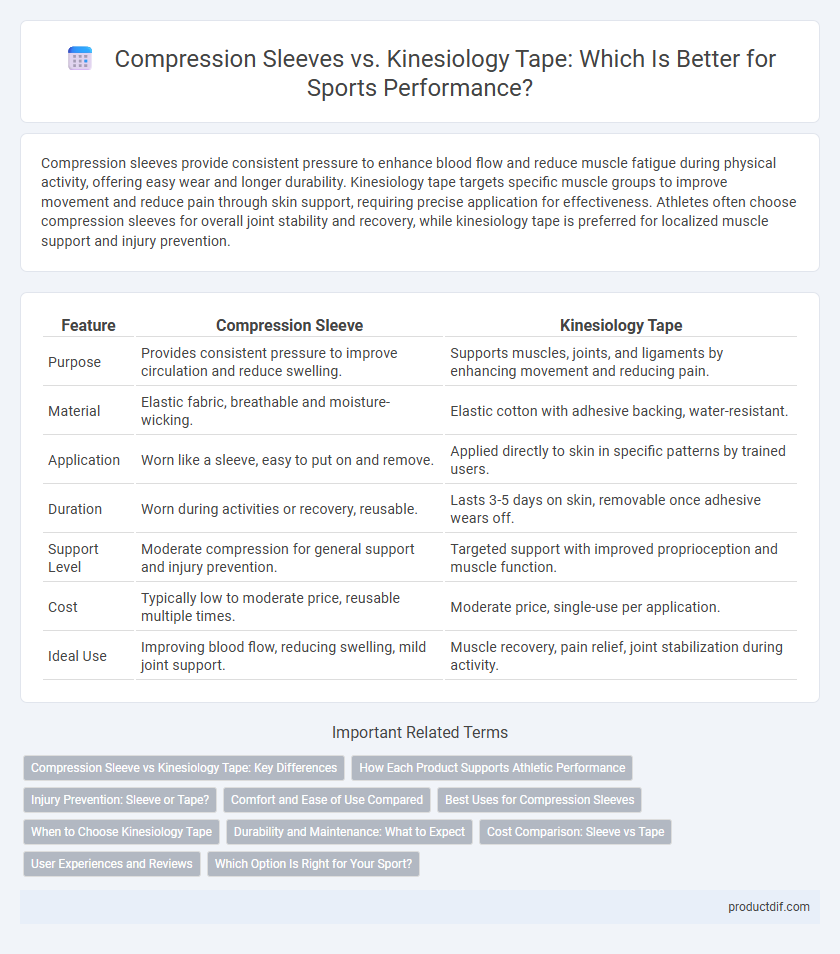Compression sleeves provide consistent pressure to enhance blood flow and reduce muscle fatigue during physical activity, offering easy wear and longer durability. Kinesiology tape targets specific muscle groups to improve movement and reduce pain through skin support, requiring precise application for effectiveness. Athletes often choose compression sleeves for overall joint stability and recovery, while kinesiology tape is preferred for localized muscle support and injury prevention.
Table of Comparison
| Feature | Compression Sleeve | Kinesiology Tape |
|---|---|---|
| Purpose | Provides consistent pressure to improve circulation and reduce swelling. | Supports muscles, joints, and ligaments by enhancing movement and reducing pain. |
| Material | Elastic fabric, breathable and moisture-wicking. | Elastic cotton with adhesive backing, water-resistant. |
| Application | Worn like a sleeve, easy to put on and remove. | Applied directly to skin in specific patterns by trained users. |
| Duration | Worn during activities or recovery, reusable. | Lasts 3-5 days on skin, removable once adhesive wears off. |
| Support Level | Moderate compression for general support and injury prevention. | Targeted support with improved proprioception and muscle function. |
| Cost | Typically low to moderate price, reusable multiple times. | Moderate price, single-use per application. |
| Ideal Use | Improving blood flow, reducing swelling, mild joint support. | Muscle recovery, pain relief, joint stabilization during activity. |
Compression Sleeve vs Kinesiology Tape: Key Differences
Compression sleeves provide targeted muscle support and improve blood circulation through consistent pressure, ideal for injury prevention and recovery. Kinesiology tape offers flexible, adhesive support that lifts the skin to enhance lymphatic drainage and reduce inflammation without restricting movement. The key differences lie in application method, level of compression, and mobility, with sleeves offering more uniform pressure and tape providing customized, dynamic support.
How Each Product Supports Athletic Performance
Compression sleeves enhance athletic performance by providing consistent pressure that improves blood circulation, reduces muscle fatigue, and accelerates recovery. Kinesiology tape supports muscles and joints by lifting the skin to improve lymphatic drainage and proprioception, which helps prevent injuries and reduces pain during movement. Both products aid in injury prevention and performance maintenance but target support through different physiological mechanisms.
Injury Prevention: Sleeve or Tape?
Compression sleeves provide consistent support and improve blood circulation, reducing muscle vibration and fatigue during physical activity, which helps prevent injuries. Kinesiology tape offers targeted support to specific muscles or joints, enhancing proprioception and stabilizing injured areas without restricting movement. Choosing between sleeves and tape depends on injury type and prevention needs, with sleeves favored for overall compression and tape preferred for localized muscle support.
Comfort and Ease of Use Compared
Compression sleeves provide consistent pressure and are easy to wear and adjust, making them a comfortable option for prolonged use during sports activities. Kinesiology tape offers targeted muscle support with flexible adhesive application, but it may require skill for proper placement and can cause skin irritation for some users. Athletes seeking simplicity and immediate comfort often prefer compression sleeves, while those needing customizable support lean towards kinesiology tape despite a steeper learning curve.
Best Uses for Compression Sleeves
Compression sleeves excel in improving blood circulation and reducing muscle fatigue during high-intensity workouts or endurance sports such as running, cycling, and weightlifting. They provide consistent graduated compression that helps minimize swelling and supports joint stability without restricting movement. Ideal for post-exercise recovery, compression sleeves also enhance oxygen delivery to muscles, accelerating healing and reducing soreness.
When to Choose Kinesiology Tape
Choose kinesiology tape when targeting specific muscle groups for enhanced support and pain relief during dynamic movements or rehabilitation exercises. Its flexible design allows for improved range of motion compared to compression sleeves, making it ideal for athletes needing joint stability without restricting mobility. Kinesiology tape also promotes better circulation and reduces inflammation, which aids faster recovery from strains or injuries.
Durability and Maintenance: What to Expect
Compression sleeves offer superior durability due to their high-quality, stretchable fabric designed for repeated use and easy washing without losing elasticity. Kinesiology tape, typically adhesive and single-use, requires frequent reapplication and careful skin preparation to maintain effectiveness and avoid irritation. Users seeking low-maintenance, long-lasting support generally prefer compression sleeves over kinesiology tape for athletic performance and injury recovery.
Cost Comparison: Sleeve vs Tape
Compression sleeves typically range from $15 to $40 per unit, offering long-term durability and multiple uses, while kinesiology tape costs around $10 to $30 per roll but requires frequent reapplication due to limited wear time. The initial investment in sleeves is higher, but their reusable nature often results in lower overall cost over time compared to the recurring expense of multiple tape rolls. Consumers should consider usage frequency and specific support needs to determine the most cost-effective option for their sports and recovery routines.
User Experiences and Reviews
Users report that compression sleeves provide consistent support and improved blood circulation, enhancing muscle recovery during sports activities. Many athletes appreciate the sleeves' durability and ease of use compared to kinesiology tape, which requires precise application and can lose adhesion during intense sweating. Reviews often highlight kinesiology tape's flexibility and targeted pain relief but note mixed effectiveness depending on application technique and individual skin sensitivity.
Which Option Is Right for Your Sport?
Compression sleeves provide consistent pressure and support to muscles and joints, enhancing blood flow and reducing fatigue during activities like running, weightlifting, and basketball. Kinesiology tape offers targeted muscle support and pain relief by mimicking skin's elasticity, ideal for injury prevention and rehabilitation in sports such as soccer, tennis, and volleyball. Choosing between compression sleeves and kinesiology tape depends on the sport's demands, injury history, and whether constant support or dynamic muscle facilitation is prioritized.
Compression Sleeve vs Kinesiology Tape Infographic

 productdif.com
productdif.com